EQIP and CSP Conservation Programs in the 2018 Farm Bill
TOPICS
Market Intel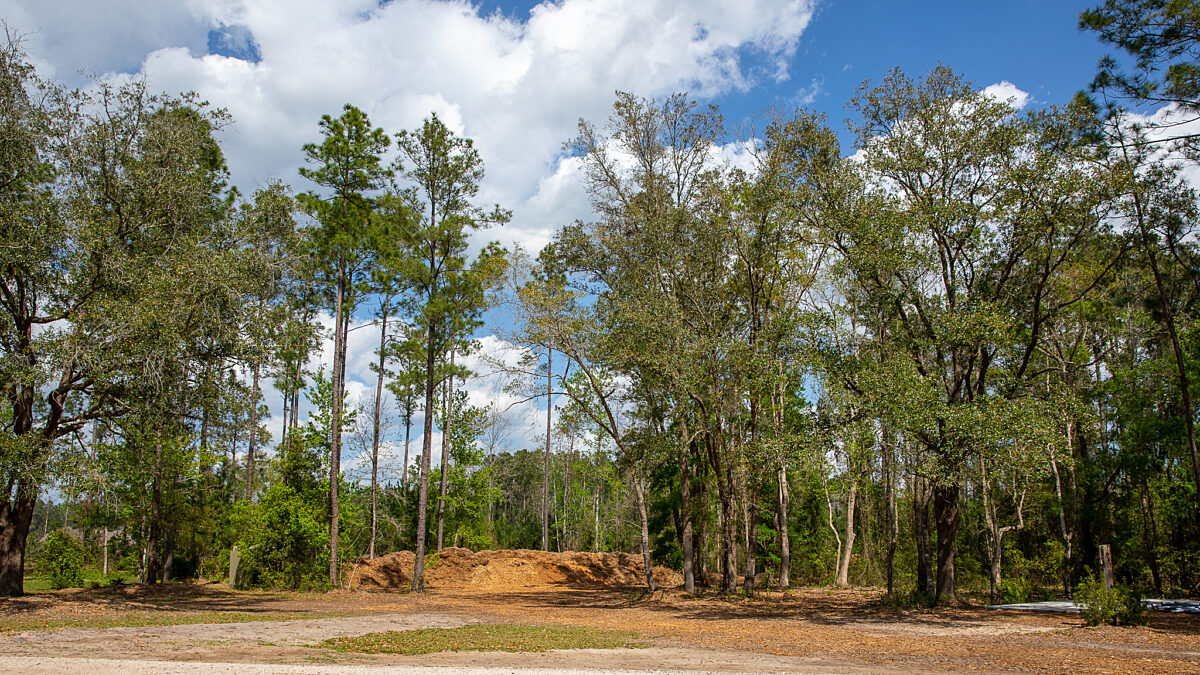
photo credit: AFBF Photo, Morgan Walker
John Newton, Ph.D.
Vice President of Public Policy and Economic Analysis
Several USDA programs are directed toward helping farmers and ranchers achieve their conservation goals. They include voluntary land retirement programs to protect natural resources, improve water quality or enhance wildlife habitat, as well as programs that provide financial and technical assistance for implementing conservation practices to address area-specific natural resource and land management concerns on active farm or ranch working lands.
A recent Market Intel article reviewed the Conservation Reserve Program in the 2018 Farm Bill. Today’s article reviews the major changes in the 2018 farm bill to the Environmental Quality Incentives Program’s and the Conservation Stewardship Program’s working lands programs.
Environmental Quality Incentives Program
Through EQIP, USDA provides financial and one-on-one technical assistance to producers and landowners for planning and installing structural, vegetative and land management practices on eligible working lands to conserve natural resources. There are hundreds of approved EQIP practices, with the most widely used EQIP practices being cover cropping, nutrient management, irrigation water management, prescribed grazing, fencing and forest stand improvements.
Data from USDA’s Natural Resources Conservation Service indicates that during fiscal year 2017 there were 11.6 million acres in the U.S. in active and completed EQIP contracts. EQIP active and completed acres were the highest in Texas at 2.8 million acres, followed by New Mexico at 1.2 million acres. The top 10 states in EQIP contracts represent 66 percent of all active and completed contracts. Figure 1 highlights active and completed EQIP acres for fiscal year 2017.
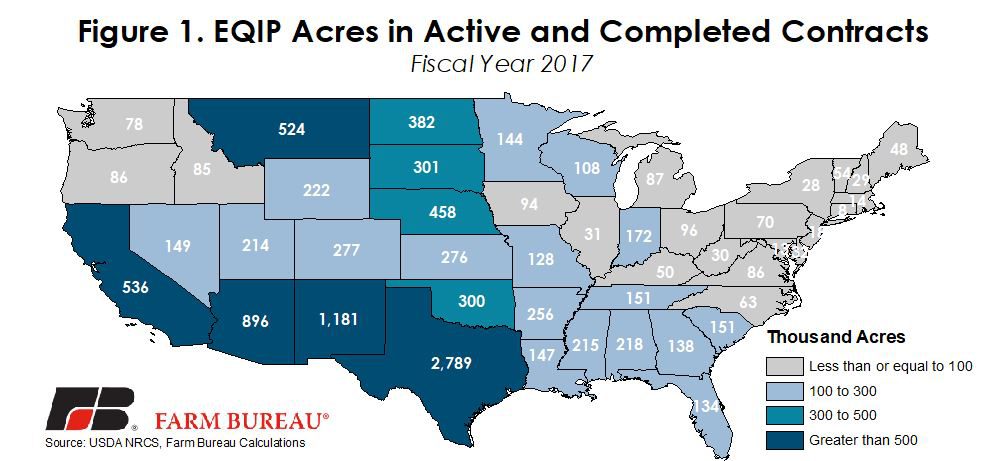
EQIP funding in fiscal year 2017 totaled $1.7 billion and included financial assistance funding of $1.25 billion and technical assistance funding of $405 million. At the state-level, EQIP funding was the highest in Texas at $158 million, followed by California at $105 million. Figure 2 highlights total EQIP financial obligations for fiscal year 2017.
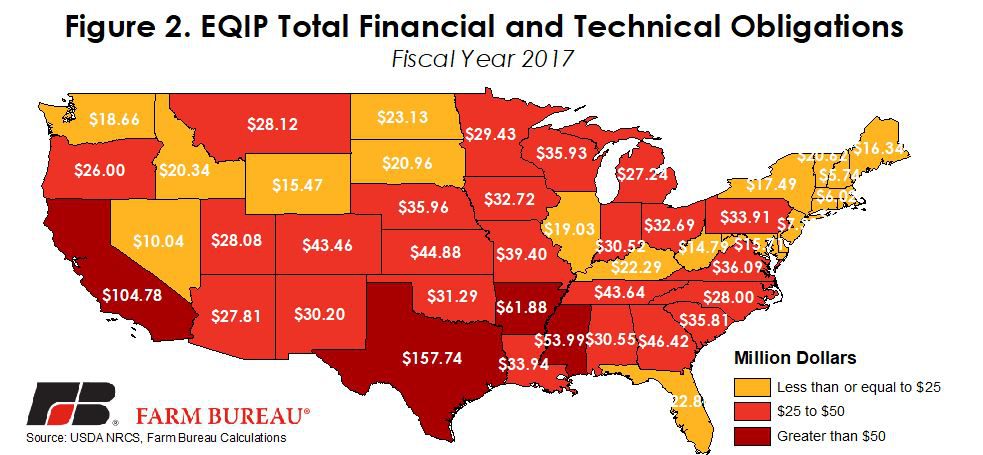
Farm Bill Changes to EQIP
The Congressional Budget Office’s June 2018 baseline projected EQIP budget authority at $19.3 billion over an 11-year period. The January 2019 baseline projects EQIP budget authority at $21.3 billion. The 2018 farm bill continues the investment in working lands programs by increasing EQIP’s budget authority by more than $1 billion. From 2019 to 2023, EQIP is authorized at $9.175 billion, with $1.75 billion in fiscal years 2019 and 2020, $1.8 billion in fiscal year 2021, $1.85 billion in fiscal year 2022 and $2.025 billion in fiscal year 2023. The increased budget authority allows for several enhancements to EQIP contracts.
First, the reimbursement rates under EQIP were expanded to up to 90 percent of the costs associated with the development, materials and implementation processes associated with state-designated high-priority practices related to excessive nutrients in groundwater or surface water, advanced drought mitigation or declining aquifers, or priority concerns in habitat or other area restoration plans. Each state may designate up to 10 practices eligible for increased payment rates.
Second, funding for conservation practices related to organic production is expanded from a maximum of $80,000 over a six-year period to up to $140,000 during the 2019-to-2023 period.
Five- to 10-year incentive contracts are also introduced to further encourage priority resource-conserving efforts and wildlife habitat preservation. Practices eligible for incentive contracts may include habitat for migratory birds, postharvest flooding, grazing, cover crops, improved crop rotations and adoption of precision agricultural techniques that efficiently use and conserve natural resources.
Importantly, under the 2014 farm bill, 60 percent of EQIP funding was designated for livestock-based initiatives. The 2018 farm bill modifies the livestock priority to 50 percent and sets aside 10 percent for wildlife-based initiatives. The shift in allocation ultimately reduces livestock’s minimum authority from $4.8 billion under the 2014 farm bill to $4.59 billion under the 2018 farm bill. In practice, livestock funding may not be reduced as generally more than 50 percent of EQIP funding goes toward livestock practices given their relative cost of implementation.
Several other modifications to EQIP were made relating to irrigation funding and soil testing, among other conservation techniques. From 2019 to 2029, EQIP’s budget authority is $21.3 billion, representing 31 percent of USDA’s budget authority for conservation programs.
Conservation Stewardship Program
CSP provides financial and technical assistance to farmers for maintaining and improving existing conservation systems as well as adopting additional conservation activities.
Since 2014, CSP enrollment data reveals nearly 77 million acres of agricultural land and forestland have been enrolled in active CSP contracts – making it the largest conservation program with respect to acreage. With 7.4 million acres, South Dakota has the largest number of acres participating in CSP over the last five fiscal years. Nebraska and New Mexico follow closely with nearly 6 million acres of CSP ground each. Figure 3 highlights CSP acres in active contracts over the previous five fiscal years.
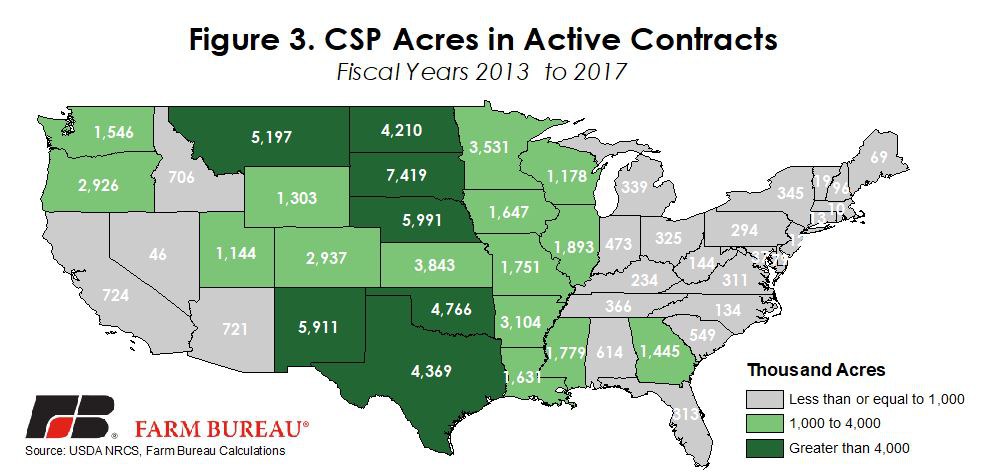
Under CSP, participants must meet a “stewardship threshold” for a set number of priority resource concerns when they apply for the program. Then they must agree to meet or exceed the stewardship threshold for additional priority resource concerns by the end of the five-year contract. In exchange, participants receive annual payments that are based, in part, on the performance of their conservation initiatives. The minimum payment for all successful applicants is $1,500.
During fiscal year 2017, total CSP financial obligations were $1.1 billion, with $239,175 in technical assistance funding and $895,360 in financial assistance. CSP outlays in fiscal year 2017 were the highest in South Dakota at $95 million, followed by Arkansas and Minnesota at $84 million and $82 million, respectively. Figure 4 highlights total CSP financial obligations for fiscal year 2017.
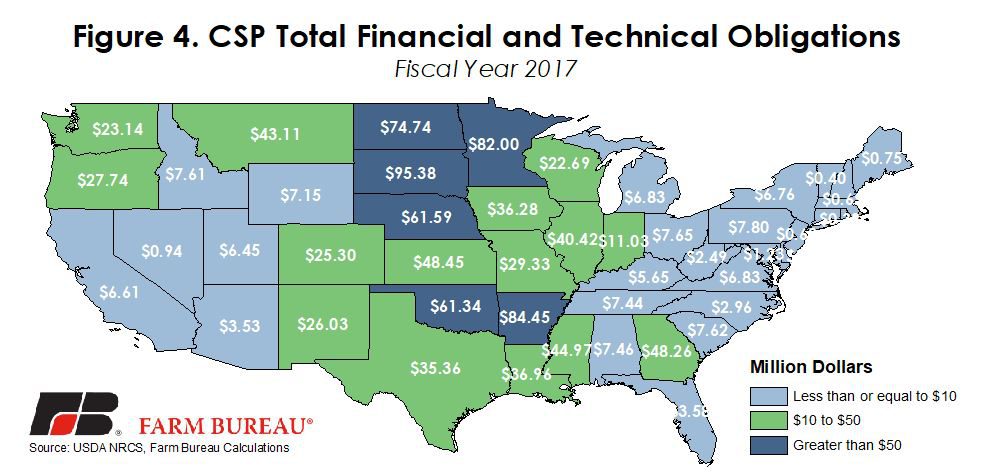
Farm Bill Changes to CSP
Early in the farm bill debate there were efforts to eliminate CSP while further enhancing EQIP. The 2018 farm bill did not eliminate CSP but did reduce mandatory funding over the 10-year life of the farm bill. The April 2018 CBO baseline projected CSP budget authority at $19 billion, including spending on old contracts. The January 2019 CBO baseline projects CSP budget authority at $15.2 billion over an 11-year period. While funding was reduced over the 10-year life of the farm bill, in the nearby years CSP funding was increased by nearly $1 billion.
For cover crop-related activities, CSP will provide an incentive payment equal to 125 percent of the normal CSP payment rate. Incentive payments up to 150 percent of the annual payment amount are also designated for resource-conserving crop rotations, management-intensive rotational grazing and advanced grazing management. Funds are also set aside to support organic production and for growers to transition into organic production.
There are also some administrative changes to CSP. First, the program changes from an acre-based program, like CRP, to a dollar-based program like EQIP. Second, the $18-per-acre average payment rate administrative target was removed. This helps to balance CSP funding among relative low-cost projects such as grasslands with high-impact and high-cost projects.
Another important modification to the CSP program is the ranking of applications and renewals based on the conservation and environmental benefits at the time of the application, as well as the degree to which the CSP activities increase resource conservation and environmental benefits. This means that CSP renewals need to compete with new applicants on the merits of the environmental benefits. The goal is to direct CSP contracts toward projects with the highest benefits and potential for continued improvement.
Summary
The Congressional Budget Office’s score of the budget authority for USDA mandatory conservation programs reflects the changes made in the 2018 farm bill. From 2019 to 2029, EQIP and CSP budget authority totals $36.6 billion. Figure 5 highlights CBO’s projection for EQIP and CSP conservation program budget authority from 2018 to 2029.
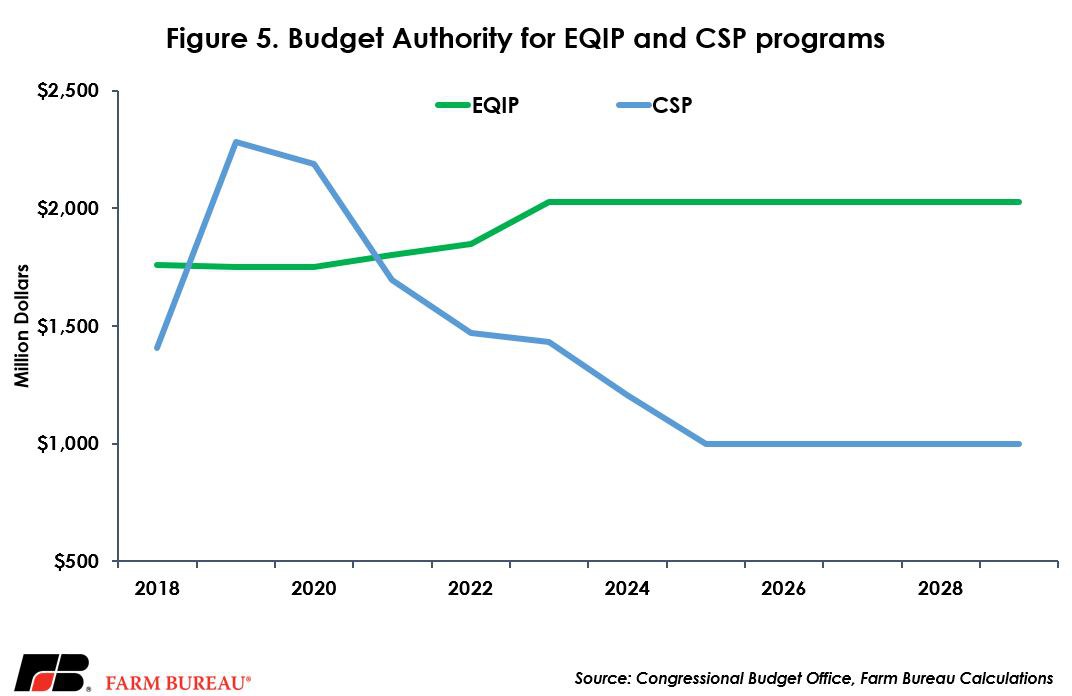
Working lands programs such as EQIP and CSP allow private land to remain in production, while providing both a cost-share and technical assistance to implement various conservation practices and address natural resource concerns specific to the area. The 2018 farm bill modifies EQIP and CSP to improve resource and wildlife conservation practices on working lands, manage soil health and improve nutrient management, and incentivizes the use of cover crops.
These changes, along with the changes made to CRP, make the conservation title the second-largest source of USDA mandatory funding related to agriculture in the farm bill at nearly $70 billion in budget authority. The financial and technical assistance provided by these programs help farmers and ranchers proactively manage soil and water quality, improve wildlife habitat and enhance carbon sequestration efforts, all of which help to enhance agricultural sustainability.
Top Issues
VIEW ALL